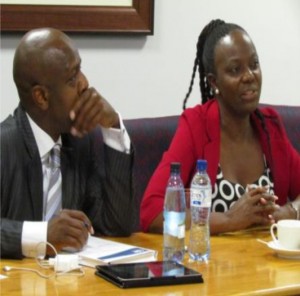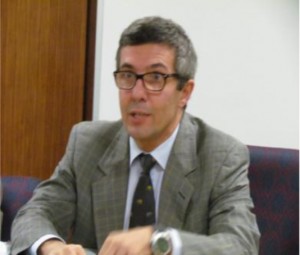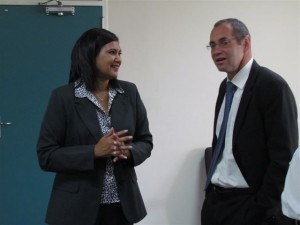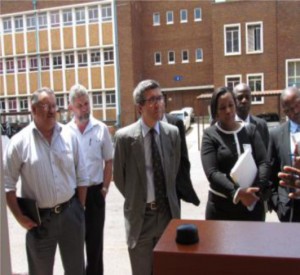The strategic relationship between DuPont and the CSIR continues to blossom. DuPont’s senior leadership visited the CSIR at its Pretoria campus late last year where the water flagship, biocomposite building, food, renewable energy and mining were identified as areas to pursue collaboration.
In her welcoming remarks, Berenice Lue Marais from CSIR Strategic Alliances and Communication indicated the importance of Africa, as well as the role that South Africa needs to play on the continent. Carl Moyo, Regional Director at DuPont Sub-Saharan Africa (SSA) and CSIR Group Executive: CSIR Strategic Alliances and Communication, Dr Rachel Chikwamba, gave opening remarks. DuPont R&D Head scientist for Europe, Middle East and Africa, Simone Arizzi was also present at the discussions.
Given that the CSIR works in the applied R&D domain while DuPont is in implementation, Rachel stated that the CSIR could either support the innovation centre, work directly with scientists at DuPont; or look at a joint R&D facility. “We are open-minded,” she added.

Regional Director DuPont Sub-Saharan Africa, Carl Moyo and CSIR Group Executive: CSIR Strategic Alliances and Communication, Dr Rachel Chikwamba
Moyo said, “We at DuPont are big believers in collaboration. No one entity can be all things to all the challenges that Africa faces. Working together, we believe we can do more. This relationship with CSIR is important because a bulk of our R&D happens in North America and Europe. It is thus essential to take some of that technology and adapt it to local conditions.”
Arizzi noted that DuPont has a student/international exchange programme for scientists, which varies from 6 to 18 months.
Rachel shared Moyo’s sentiments and said that while trying to find areas of collaboration, the two organisations “noted that as technologies become outdated, they need to be adapted to be suitable for certain environments and we felt that this was a role that the CSIR could play very well”. She highlighted that the CSIR was also engaged in its own novel thinking in the areas of biocatalysts, building engineering etc. “As a public institution, we are mandated to make technologies that will make South Africa more competitive and that will solve socio-economic challenges of the country. As such, we are encouraged to form relationships with suitable partners in order to achieve that vision, which we are tasked with by our government. It is in this light that we are viewing DuPont as a strategic partner.”
Moyo explained that in order to take the CSIR/DuPont partnership to new heights, it is important to introduce DuPont chief scientists to the CSIR.
“Opportunities are clearly there. We can now put some formalism and prioritisation by ensuring that these areas are not just exciting from a technology point, but that they make business sense,” added Arizzi.
The following presentations were made at the discussions:
- Water technologies — Laurie Barwell (CSIR Natural Resources and the Environment)
- Renewable energy — Dr Mkhulu Mathe (CSIR Materials Science and Manufacturing) and Brian Tsikada (DuPont SSA)
- Roads — Dr Martin Mgangira (CSIR Built Environment) and Richard Ntombela (DuPont Packaging and Industrial Polymers)
- Affordable housing — Dr Joe Mapiravana (CSIR Built Environment) and Michael Peter (DuPont Building Innovations).
Berenice noted that some of the projects needed to be fleshed out and would be put forward to the delegation just before December 2013 in order to define the partnership further.
The delegates visited the CSIR’s low-cost housing site; and the sanitation site where they were hosted by Llewellyn van Wyk and Louiza Duncker from CSIR Built Environment.
Moyo thanked Executive Director: CSIR Built Environment, Dr Cornelius Ruiters, for co-hosting the event with Berenice. He said, “We have definitely tested and seen that the partnership with the CSIR can be beneficial and we are happy that it is continuing. Thank you Berenice and Bjoern Meth – for keeping up the energy and everyone up to speed.”



